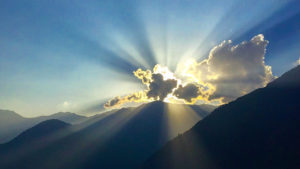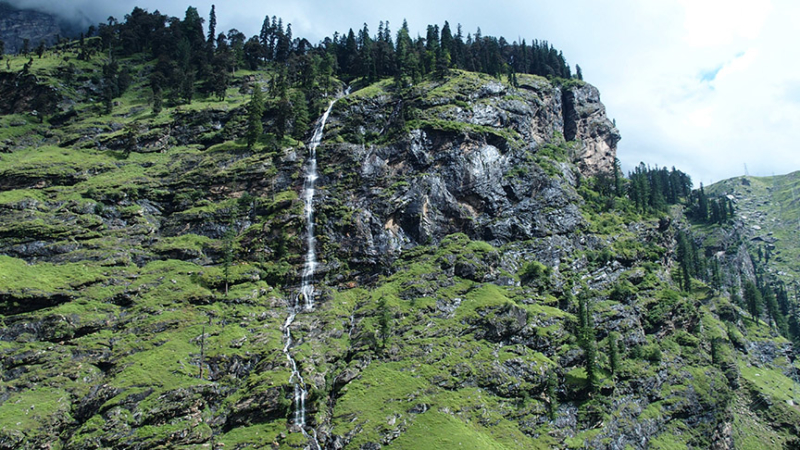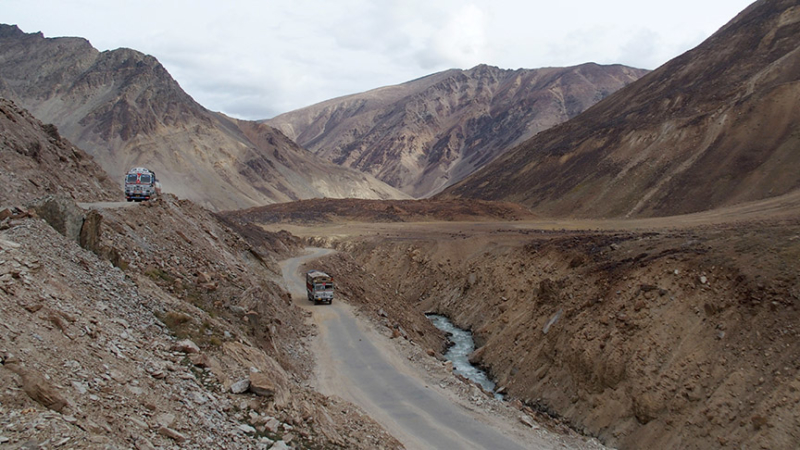When we first arrived in India, there were two environmental factors that narrowed down our options considerably. It was monsoon season and many parts of the country were extremely hot. We met a couple in Sri Lanka who had just come from India and they showed us pictures of cars floating down the massively flooded streets. I saw no reason to intentionally put ourselves in that situation. The obvious plan was to get as far north as possible, hopefully beyond the range of the monsoon air mass, and wait for the rains to subside. Then we could slowly work our way southward in the pleasant autumn weather.
It just so happens that there is a perfect place wait out the monsoon – Leh. The northernmost state of India, collectively known as Jammu and Kashmir, is far enough north and high enough up in the mountains that the monsoon has little effect there. Leh is the largest town in a region in eastern Jammu and Kashmir called Ladakh. Don’t ask me why it’s not called Jammu, Kashmir, and Ladakh. Fern and I had heard and read that Leh is an incredibly beautiful place. Perfect.
We initially flew into New Delhi so we just needed to get to Leh as soon as possible. We took a long bus ride to Manali, which is a good step up into the wet green mountains, and from there we arranged a bus ride directly to Leh. It would be a two day bus ride with an overnight rest stop in Keylong.
The first leg of the journey would take us north through the Kullu Valley to the first of several high mountain passes – the Rohtang Pass. The road basically runs right up the side of a very steep incline through a long series of switchbacks and stunning green mountain scenery and it finally crosses the pass at 13,050 feet in altitude. The road is extremely curvy and bumpy and this is the new and improved road. Fortunately we made the right decision to take some motion sickness medicine.
The condition of this road is so rough that it’s actually humorous although if someone has problems with anxiety they might have a little freak-out when they look out the window and consider their safety. Some parts of it are paved and many parts are not. The parts that aren’t have huge potholes, rocks, deep mud, and other types of obstacles. Many parts of the road have been severely eroded by flowing water and frequent landslides cover the road with boulders and debris. It’s just barely wide enough for two smaller vehicles to barely squeeze by each other and in many places one side crumbles off down a steep cliff with no guard rail or even a clear edge to the road. It would make sense if this were some sort of defunct off-roading trail but in reality this is one of two main routes into Ladakh and there are lots of ordinary cars, full size buses, motorcycles, oil tank trucks, construction vehicles, and heavy duty military trucks using this road.
On the second day we were supposed to be ready to leave at 4:00 a.m. As the sun came up we saw a completely different landscape than the day before. Very little moisture makes it past the Rohtang Pass and instead of vibrant green valleys we saw a mountainous desert with colorful craggy rock formations and pillowy mounds of minerals, sand, and dust. The altitude through the stretch between Keylong and Leh is considerably higher and we ascended a couple of even higher passes, the highest of which was almost 17,500 feet at Taglang Pass. It was hard for me to imagine many living things surviving in such a place and indeed, there were few plants, animals, or even people. Maybe it was the lack of oxygen or the sedating effect of the motion sickness medicine but to me it seemed an otherworldly place.
There were a couple of towns with incredibly beautiful (and ancient) terraces for farming and there were a few other very small settlements consisting of temporary structures which largely pack up and head somewhere else during the high Himalayan winter. They cater mostly to local travelers, road workers, and the occasional gaddi (shepherd). The people who live and work in this area are a special breed. It seemed to me that there were quite a few displaced Tibetans and many of the transient road workers were from Nepal or the corrupt underdeveloped state of Bihar. They endure an incredibly harsh environment but there is something special about their smiles. Their eyes glow through weathered skin and layers of clothing that probably almost never come off, like piercing rays of sunshine emerging through masses of dark clouds.

jim@snorkelbandits.com



